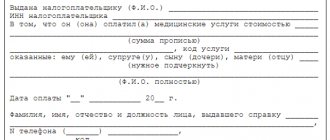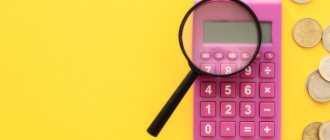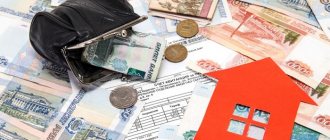Home/Trade/VAT on services and transactions
Value added tax is imposed on a wide range of transactions and services, but there is also a list of those that are not subject to this tax. The possibility of refusing to pay VAT is associated with social expediency - it is on this basis that the exemption from payment is formed. Minimization or the possibility of refusing payments are relevant as support measures for start-up businesses, for domestic manufacturers in general, competing with foreign suppliers.
For your information
Medicine, education and other socially significant areas are also exempt from payments, which is quite natural.
Normative base
Within the framework of VAT legislation, Art. 149 of the Tax Code of the Russian Federation, which provides not only basic explanations, but also regulates the list of services and areas that are exempt from payments. This list is indicated in paragraph 3 of Art. 149 of the Tax Code of the Russian Federation, after reading it, the taxpayer can clarify whether there is a need to pay tax in his case.
Attention! If you have any questions, you can chat for free with a lawyer at the bottom of the screen or call Moscow; Saint Petersburg; Free call for all of Russia.
Services related to the sale of precious metals
Situation: can an organization use VAT benefits when providing services related to the sale of precious metals to the Bank of Russia (sorting, weighing, packaging, storage)?
No, he can not.
In accordance with subparagraph 9 of paragraph 3 of Article 149 of the Tax Code of the Russian Federation, it is the sale of precious metals on the interbank market that is exempt from VAT. At the same time, tax legislation means the transfer of ownership of property from one person to another on a compensated and gratuitous basis (clause 1 of Article 39 of the Tax Code of the Russian Federation). The benefits provided for in subparagraph 9 of paragraph 3 of Article 149 of the Tax Code of the Russian Federation do not apply to services for sorting, weighing, packaging and storage of precious metals.
What is VAT?
VAT is an indirect tax that is levied on both goods and services. It is calculated as an additional cost, paid from the cost of the service or operation by the end consumer in favor of the country's budget. The peculiarity of this tax is the fact that tax receipt is possible even at the production stages. If we talk about services, it is formed from those operations that are provided in the process of producing the final result, remaining relevant at all stages. The basic rate for VAT is 18 percent, and Russian legislation also provides for the possibility of using a reduced rate of 10 percent, or a zero rate, as well as a complete exemption.
Additional Information
VAT has some similarities with turnover or sales tax and is also added to the total cost of the service. However, there are significant differences in this regard. Thus, the seller of services for which the buyer pays VAT included in the total price can deduct from the amount paid by the buyer those figures that were paid the same tax to the supplier.
The tax remains indirect; it is paid by the buyer. Payment papers require separate registration of VAT on services and transactions; a special line is allocated for this. In general, this version of the tax system is formed to achieve several goals at once:
- Distribution of the tax payment process between the stages of production and commerce, while eliminating the risk of multiple collections and overpayments, which can become very serious.
- Distribution of responsibilities between several payers, eliminating the risk of non-payment. The specifics of taxation in this regard are such that the required amount will still be withdrawn for the budget, even if one of the participants in the process evades taxes. Care is possible only when using the most complex schemes.
- Receiving an indirect tax excludes national ones; this is convenient within the current economic situation.
How to distribute input VAT
Separate VAT accounting is the basis for the distribution of input tax. It is needed if it is not possible to accurately determine in what type of operations the goods, works and services will be used. Most often this concerns fixed assets, materials, works and services that are part of general production or general business expenses. For example, external consultations, rent payments, utility bills, etc.
Based on accounting data, the accountant can determine which amount of VAT relates to taxable transactions and is subject to deduction, and which relates to exempt transactions and should be included in the cost or expensed.
VAT may not be distributed if during the quarter the share of non-VAT taxable transactions does not exceed 5%.
5% rule - when VAT may not be distributed
If in a quarter the share of expenses for the purchase, production or sale of objects not subject to VAT did not exceed 5%, the entire input VAT can be deducted.
Calculate the share of expenses using the formula:
Share of expenses = Expenses for the purchase, production and sale of objects not subject to VAT for the quarter / Total amount of expenses for the purchase, production and sale for the quarter × 100%
This rule does not work in the opposite direction. If the share of transactions subject to VAT does not exceed 5%, the tax will still need to be distributed (letter of the Ministry of Finance dated August 19, 2016 No. 03-07-11/48590).
Note! You cannot deduct VAT claimed on items that are used only in non-taxable transactions. Even if the costs for them did not exceed 5% (clause 4 of Article 170 of the Tax Code of the Russian Federation, Letter of the Ministry of Finance dated April 23, 2018 No. 03-07-11/27256).
How to calculate the proportion for the distribution of input VAT
If the 5% rule is not met, you need to distribute all VAT among objects used in taxable and non-taxable transactions and understand how much to deduct and how much to include in expenses. Distribute VAT at the end of the quarter in which the property was received, work or services were taken into account.
To do this, a proportion of revenue is drawn up based on the 3rd and 7th sections of the VAT return. The formulas are as follows:
Share of VAT to be deducted = ST region / ST general Share of VAT to be included in the cost = ST neoreg / ST general, where:
- ST region - the cost of goods, works, services shipped during the quarter, the sale of which is subject to VAT;
- ST neobl - the cost of goods, works, services shipped during the quarter, the sale of which is not subject to VAT;
- ST total - the total cost of goods, work, and services shipped during the quarter.
To calculate the proportion, determine the cost without VAT - this will help ensure comparability of indicators and not distort tax obligations. Also, consider only the cost of goods, works or services shipped.
Based on the results of calculating these indicators, generate an accounting certificate.
Register invoices from suppliers in the purchase book for the amount of VAT, which can be deducted based on the calculation results.
Example of VAT distribution
Matryoshka LLC shipped goods worth 1 million rubles during the quarter, of which:
- 200,000 rubles - not subject to VAT;
- 800,000 rubles (excluding VAT) - subject to VAT.
During the quarter, containers were also purchased, which were used in both taxable and non-taxable transactions. Input VAT on packaging was 18,000 rubles. It must be distributed in proportion to the share of non-taxable and VAT-taxable transactions in the total volume.
- Share of VAT deductible = 800,000 / 1,000,000 = 0.8;
- Amount of tax to be deducted = 18,000 × 0.8 = 14,400 rubles;
- Share of VAT included in the price = 200,000 / 1,000,000 = 0.2;
- Amount of VAT included in the price = 18,000 × 0.2 = 3,600 rubles.
Features of separate accounting for fixed assets and intangible assets
If fixed assets or intangible assets are used in taxable and non-taxable transactions, VAT must also be distributed on them. The distribution procedure is similar, but there is a nuance: the tax period for VAT is one quarter and based on its results, VAT is calculated, which is included in the price.
Everything is fine if the fixed asset was purchased in the last month of the quarter. But if it was purchased in the first or second month, then at the time of acceptance for accounting you will not have data to determine the amount of VAT that needs to be included in the price of the object.
In this case there are two options:
- Calculate the proportion based on the results of the quarter. The fixed asset must be accounted for at its original cost excluding VAT. Based on the results of the quarter, calculate the amount of VAT to be included in the cost of the fixed asset, adjust the original cost and recalculate depreciation. This will look similar to correcting accounting errors.
- Calculate the proportion based on the results of the month of acquisition. In this case, based on the results of each month, it is necessary to quickly determine the revenue subject to and not subject to VAT. That is, the VAT tax base will have to be calculated monthly, not quarterly.
Note! Special rules apply to real estate. If it is used in taxable and non-taxable transactions, the full amount of input VAT is claimed for deduction at the time the property is accepted for accounting. Then, within 10 years, part of the VAT claimed for deduction will have to be restored according to the rules of Art. 171 Tax Code of the Russian Federation.
Features of separate accounting for transactions with securities
Transactions with securities are exempt from VAT. If you do them, then you need to keep separate records for input VAT.
To calculate the distribution proportion, you will also need revenue. But if we are talking about revenue from transactions with securities, then it is not necessary to take into account its entire amount, but only the amount of income from sales.
Income from the sale of securities = Proceeds from the sale of securities - Expenses for the purchase and sale of securities
If the sale results in a loss rather than an income, do not take it into account in proportion.
Keep records of exports and imports in the Kontur.Accounting web service. Simple accounting, payroll and reporting in one service
What services are subject to VAT?
VAT is levied on a wide range of services provided on the territory of the Russian Federation, and this issue is regulated by Chapter No. 21 of the Tax Code of the Russian Federation. Almost all services are taxable, however, there is a list of exceptions approved by law in accordance with Articles No. 145, No. 149 and No. 150 of the Tax Code of the Russian Federation. Among the exceptions that are not subject to the fee, it should be noted:
- Licensed medical services except veterinary and cosmetology, not sponsored by the budget.
- Child care in specialized preschool institutions.
- Sections and clubs for children.
- Care for the elderly and disabled.
- Collection of duties and fees, related services.
- Funeral services.
- Renting premises to foreigners.
- Working with deposits and securities.
- Maintenance of vessels - river, sea, air.
- Non-profit services in the spheres of culture and art.
- Pharmacy services - manufacturing medicines, frames, repairing hearing aids, and so on.
- Transportation of people subject to a single tariff.
- Extinguishing fires in forests.
- Lawyer services.
- Guaranteed repair services at no additional charge.
What transactions are subject to VAT?
Regarding transactions, the situation is similar - almost all of them require payment of VAT, but there is a list of exceptions that are not subject to additional taxes. Exceptions established by law are worth listing. Thus, the following transactions are not subject to tax:
- Licensed banking activities except for collection, loans other than in kind (through the use of goods), operations with stones and precious metals.
- Transfer of infrastructure facilities to self-government bodies and authorities.
- Privatization of enterprises.
- Insurance, provision of pensioners of a non-state nature.
- Sale of land.
Attention
All other transactions require payment of tax.
What types of activities are not subject to VAT?
There is a list of activities that are not subject to VAT. First of all, these are socially significant areas, the cost of services within which should not increase. It is worth listing the following types of activities that are not subject to VAT in this case:
- Sphere of investment.
- Construction of any facilities for military personnel, including housing and infrastructure.
- When operating an organization whose staff consists of 80 percent or more disabled people, or if up to 80 percent of the authorized capital is formed by contributions from organizations of disabled people.
- The work of the International Olympic Committee.
- Charity.
- Budgetary research activities.
- Restoration of historical and cultural monuments.
- Cinema.
When working in any of these areas, there is no need to pay VAT.
Who is exempt from paying VAT?
VAT is also exempt in other situations. Thus, there is no need to pay this tax if the organization or individual entrepreneur belongs to the sphere of small business, and a simplified taxation system is used. In this case, it becomes necessary to pay tax according to the developed “Income” or “Income minus expenses” schemes, and payment of VAT is not required. In addition, VAT does not need to be paid to those organizations that work under the agricultural tax regime.
IMPORTANT
It is worth knowing that the list of conditions for VAT exemption, as well as the list of services and goods subject to exemption, is revised from time to time, and innovations arise periodically in this area. Exemption is a regulated phenomenon and exempt companies are subject to supervision and control.
simplified tax system
Organizations using the simplification must pay VAT only in the following cases:
- when importing goods (clause 2 of article 346.11 of the Tax Code of the Russian Federation);
- if the buyer is issued an invoice with an allocated amount of VAT (clause 5 of Article 173 of the Tax Code of the Russian Federation);
- if the organization conducts general affairs in simple partnerships, is a trustee or concessionaire (clause 2 of article 346.11, article 174.1 of the Tax Code of the Russian Federation).
In addition, organizations applying the simplification are not exempt from fulfilling the duties of a tax agent to withhold and pay VAT (Article 161 of the Tax Code of the Russian Federation).
Value added tax calculation
Calculating VAT is quite easy; for this purpose there is a formula NB × Nst / 100 ,
Where NB is the total amount, that is, the tax base, and the rate can be equal to 10 or 18 percent.
When isolating the tax from the total amount, you can apply the following formula: C / 1.18 × 0.18 (or × 0.10)
C/1.10 —rate 10%,
C - total amount including VAT.
If you need to find the amount including tax without calculating it in advance, you can use the formula C = NB × 1.18 (or 1.10)
NB - total amount without tax, base.
Estimated rates accepted in the VAT system
The legislation provides for cases in which tax is calculated not at regular rates, but at calculated rates . They are calculated as the ratio of the regular tax rate to the increased tax base, which looks like the sum of 100% and the regular rate. The diagram looks something like:
Estimated Rate = Tax Rate / (100 + Tax Rate)
Cases of application of estimated tax rates:
- Receiving funds from the sale of products, as well as receiving an advance;
- Transfer of property rights;
- Cars sale;
- Sale of agricultural products, etc.
Possible errors in calculations
An error can creep into any calculation, but mathematical inaccuracies are not the main problem area for VAT. They happen rarely, and if we talk about errors in formation and payment, then first of all it is necessary to note other factors.
For your information
Sometimes, by mistake or intentionally, they use a low interest rate in a situation where it would be legal to use the main one. Sometimes they are late with the calculation and payment of VAT, or do not take into account partial payment already received for a service or product. Sometimes VAT is deducted without transferring it to the supplier, and errors often occur due to the fact that incorrectly drawn up and completed invoices are received.
Since VAT on services and transactions is one of the most important, and fines for violations and non-payment of tax can be very serious, it is worth paying the necessary attention to calculations, and hiring only competent specialists for accounting work who can confidently cope with all the nuances of the issue.
Typical errors in VAT management
Inconsistency between buyer and seller amounts
A fairly common situation is when an audit by the tax office reveals some discrepancies in amounts between the buyer and the seller. This entails consequences in the form of providing clarifying documents and the accrual of penalties in case of underestimation of the amount of tax paid.
Errors in invoices and primary documents confirming the right to a tax reduction
The discovery of errors in documents confirming the right to a tax reduction can lead to problems during an audit by the tax inspectorate. Which can subsequently also lead to problems for the organization.
Accounting entries
Value added tax and the correct execution of papers associated with it are assigned to tasks that must be solved mainly by an accountant. Modern systems greatly simplify this activity, and there are two points under VAT. First of all, account 19 is used, where you can open sub-accounts - the column is reserved for VAT on purchased values. There is also account 68 called Tax calculations, where a subaccount is allocated for VAT.
Additional Information
Using specialized accounting tools, you can successfully calculate value added tax with a minimum of effort and avoid breaking the rules.








